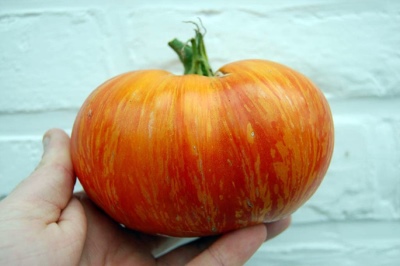
- Category: grade
- Growth type: indeterminate
- Appointment: fresh consumption
- Ripening period: mid-season
- Bush size: tall
- Bush height, cm: 120-150
- Bush characteristic: powerful
- Leaves: large
- Fruit shape: flat-round
- Fruit weight, g: 300-500
Tomato fruits are believed to be not only tasty, but also beautiful. However, even the most promising name does not mean that the peculiarities of such a variety can be ignored. And a careful study of the King of Beauty can provide summer residents with valuable consumer information.
Description of the variety
The king of beauty is a typical indeterminate culture. It is worth noting that it was bred in the USA and has an official synonym for Beauty King. Its bushes reach a fairly large height. Plants from 1.2 to 1.5 m are described, and in a number of sources even two-meter specimens are mentioned. In addition, tomatoes have a powerful development. Large leaves are formed on them.
The main qualities of the fruit
The Beauty King berries are also quite large. Their average weight ranges from 300 to 500 g. In shape, the fruit resembles a flat circle. As tomatoes ripen, they become more and more red, and the color brightness only increases. The brushes develop over the 8th leaf.
Taste characteristics
It has a generally sweet taste. However, some sour note is still present. Consumer confidence in this variety is also associated with the expressive meatiness of the berries.
Ripening and fruiting
The King of Beauty will ripen at the same time as other mid-ripening tomatoes. After the formation of shoots, on average, the readiness of the crop is reached at 118 days. However, it must be remembered that in domestic conditions the climate is not as favorable as in the homeland of this tomato. Therefore, sometimes the schedule can shift significantly.
Yield
The collection can be 5.5-7 kg per 1 bush. Such a spread is primarily associated with the effect of weather, which often interferes with or helps to achieve the desired result. But the agricultural technology of growing tomatoes also plays an important role, without taking into account the requirements of which even the King of Beauty will not give a good harvest. This agricultural technique is generally standard, but must be followed impeccably.
The timing of planting seedlings and planting in the ground
Seed sowing in containers is approximately carried out from March 1 to March 15. At this point, about 60 days remain before landing in open land. The seeds are buried by a maximum of 1.5 cm. It is necessary to keep such plantings under a film in a dark place. Before stretching the film, the ground is sprayed. Hardening of seedlings before transshipment into open ground is mandatory.

Growing tomato seedlings is an extremely important process, because it largely depends on whether the gardener will be able to harvest at all. All aspects must be taken into account, from seedbed preparation to planting in the ground.
Landing scheme
For 1 sq. m should have 4 holes. If there are fewer of them, it will not work to achieve a good harvest. At higher densities, plants interfere with each other and make work more difficult, which also turns into additional problems. The gap between the individual holes is normally 40 cm.The row spacing is also 40 cm.

Growing and care
Water consumption per 1 bush during irrigation is at least 700 ml. This should be done in the afternoon. But if the weather is cloudy, then you can water the plants at any time convenient for summer residents.
Other guidelines for cultivating the Beauty King are as follows:
the bushes are loosened every 10 days;
the first hilling is carried out at the end of the first decade in a permanent place;
mineral mixtures need to be applied once every 14 days before the ovaries form;
the bushes should be formed in an optimal way and firmly tied to the support;
The king of beauty must be protected from fluctuations in humidity and temperature fluctuations;
in case of any infectious lesions, diseased plants are usually destroyed, and the earth is carefully dug up.




A plant needs different micronutrients at each stage of growth. All fertilizers can be divided into two groups: mineral and organic. Folk remedies are often used: iodine, yeast, bird droppings, eggshells.
It is important to observe the rate and period of feeding. This also applies to folk remedies and organic fertilizers.


Review overview
Many gardeners point out that this is one of the best varieties they have ever planted. Such a plant, indeed, justifies all the declared characteristics and allows you to achieve success. The taste of the fruits is fully consistent with their graceful appearance. Productivity, according to some estimates, is at an average level. There are no special problems in the cultivation of such a tomato.

























































































